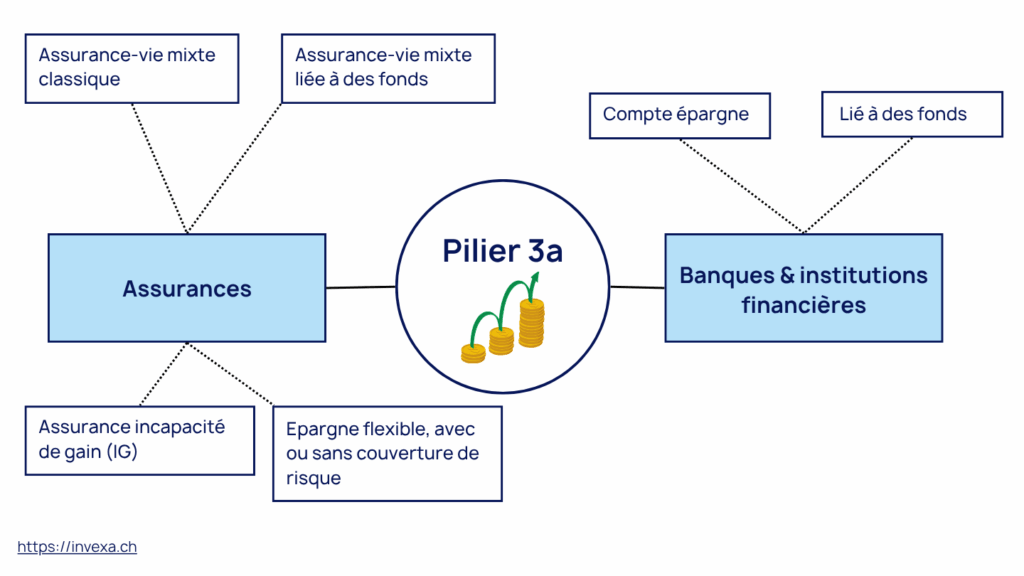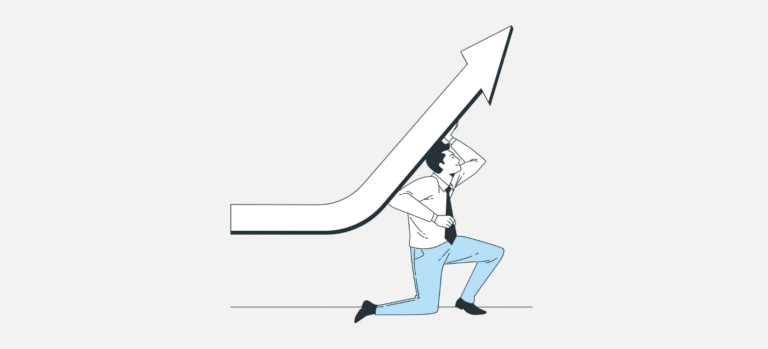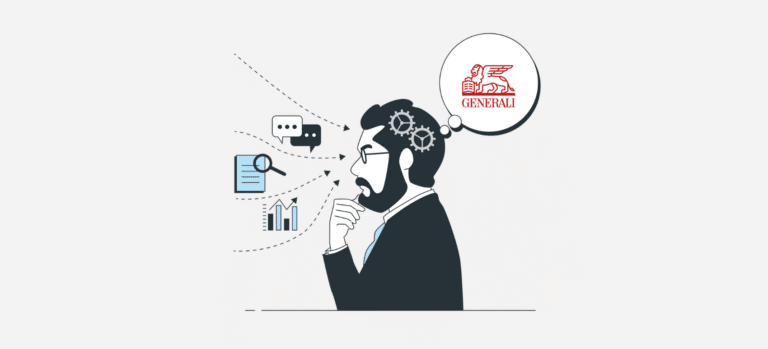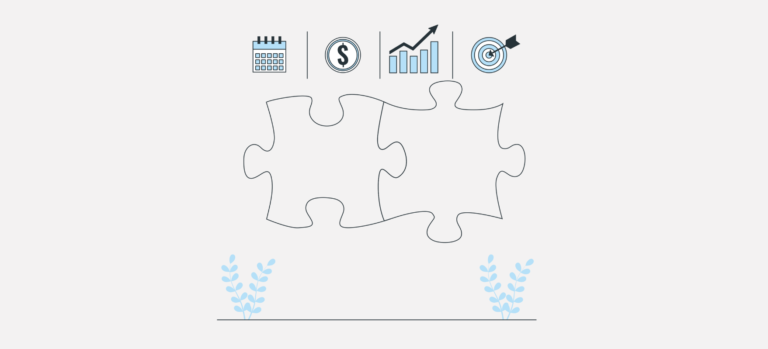Pillar 3a at a glance
- Pillar 3a allows you tosave for retirement while enjoying a tax deduction yearly.
- Ceiling for 2025: CHF 7,258 for employees affiliated to the 2nd pillar / up to 36,288 CHF (20 % of income) for the self-employed.
- Any person exercising a gainful activity subject to OASIincluding cross-border commuters.
- Withdrawal possible between -5 and +5 years retirement or earlier under certain conditions.
- Withdrawn capital is taxed separately at reduced rate, according to the canton.
What is a 3rd Pillar A?
Introduced into the Constitution in 1972, Pillar 3a represents the tied individual pension plan. It is characterized by its favorable tax framework and has the primary goal of preparing for retirement. This private pension scheme is a voluntary savings plan that complements the first two pillars (AVS and pension fund) and, in exchange for tax deductions, comes with restrictions on withdrawals. The accumulated funds can only be accessed in cases of retirement, disability, death, or the purchase of a first home — under certain conditions.
Who can open a linked pension account?
The opening of a pillar 3a account or policy is available to anyone residing in Switzerland, whether employed or self-employed, but you must exercise a gainful activity and therefore earn an income subject to OASI. The 3a pillar is also available to cross-border workers.
Possible shapes
There is a wide range of options within tied pension provision. We generally distinguish between two main categories: Pillar 3a with a bank and Pillar 3a with an insurance company.
At the bank
In a bank, several products are available under the tied pension scheme (pillar 3a). On one hand, there is the dedicated savings account, which generally offers a guaranteed interest rate and high capital security, but provides limited returns.
On the other hand, investment products, such as investment funds or ETFs, offer the possibility of achieving potentially more attractive returns by investing in a diversified portfolio. However, they carry risks linked to market fl
Finally, hybrid solutions combine capital guarantees with a dynamic investment component, offering a balance between security and performance.
In insurance
In insurance, Pillar 3a offers products designed to combine savings and protection. Life insurance contracts allow you to invest in a product that provides capital guarantees while also including coverage in the event of death or disability.
There are many forms, such asfund-linked endowment insurance in case of life, thedisability insuranceetc. Remuneration may vary according to the performance of the chosen investments, although some contracts offer guaranteed rates. In all cases, we strongly recommend that you compare 3rd pillar solutions in detail, given the many options available on the market and the variation in fees from one provider to another.

Contribution limits
In 2025, it will be possible to pay out the following amounts in tied personal pension plans:
- Employees affiliated to a pension fund: Up to CHF 7,258 / year
- Self-employed or employees not affiliated to a pension fund: 20% of income, maximum CHF 36,288
Under what conditions can I make a withdrawal?
The early withdrawal conditions of the 3rd pillar A are strictly regulated to ensure that savings remain earmarked for provident provision and retirement. Here is a breakdown of the various situations in which it is possible to make an early withdrawal, either partially or in full:
1. Retirement age
Retirement benefits can be paid out as early as 5 years before the insured person reaches the standard OASI retirement age (“reference age”), and at the latest five years after.
2. Purchase of 2nd pillar contributions
Early withdrawal is permitted when the Pillar 3a savings are used to buy back contributions into a second-pillar pension institution. This option allows you to supplement or regularize your occupational pension capital in case of gaps.
3. When receiving a full DI/IV pension
If the client receives a full disability pension from the DI and the risk of disability is not covered by the pension plan, the early withdrawal can be activated.
4. Change of self-employed activity
Early withdrawal is also possible for the policyholder who changes to a new self-employed activity. This allows access to the necessary liquidity to support their professional transition.
5. Starting a self-employed business
If the pension fund member sets up their own business, they can apply for early withdrawal. The aim is to provide financial support when starting a self-employed or entrepreneurial activity, which is often crucial in the early stages of setting up a business.
6. Final departure from Switzerland
If the policyholder permanently leaves Switzerland, they may make an early withdrawal of their funds. This provision is intended to allow the insured person to access their savings when settling abroad.
7. Home purchase or mortgage repayment
Early withdrawal is also possible when the funds are used to purchase a home for one's own needs or to repay mortgage loans. This condition facilitates home ownership by allowing insured persons to use their savings in a practical way for a real estate project.
Get your personalized comparison
Fill in our 3rd pillar quotation request form and one of our pension experts will contact you shortly with a quotation. customized, no-obligation analysis.
What are the tax benefits of Pillar 3a?
The contributions paid are deductible from taxable income, which helps reduce annual taxation. In addition, upon withdrawal, the capital is taxed at a reduced rate — at one-fifth of the normal income tax.
Furthermore, during the term of the contract, no wealth tax will be levied, allowing capital to grow without additional costs.
How many 3a accounts can I have?
There is no legal limit to the number of 3a accounts you can hold. In practice, you may open several accounts — for example, a bank account and a life insurance policy.
However, the annual contribution ceiling remains the same and applies to the total of all your payments, which means that the total amount deposited cannot exceed the ceiling set by law.
New: 3a redemptions
In 2026, it will be possible to make subsequent 3rd pillar A purchases for the 2025 tax year of CHF 7,258 (ceiling).
Succession in 3a
When you pass away, the assets in your pillar 3a do not follow the traditional rules of inheritance. They do not enter directly into the estate: they are paid out first to the beneficiaries provided by law or those you have designated in your clause. In practice:
- First, the surviving spouse or the registered partner is protected.
- Next come the children.
- Failing this, other close relatives may be appointed, within the limits set by theOPP3 ordinance.
You can specify in your contract how this capital is to be distributed among your beneficiaries. This avoids conflicts and ensures that your wishes are respected. Please note: if your designations affect the reserved portion of your legal heirs, they may request a reduction. In this case, the surrender value of your 3a is included in the calculation of the estate.
Pillar 3a vs. 3b: which to choose?
There are two variants within the third pillar. Pillar 3a is a form of tied retirement savings that offers significant tax deductions. The funds are locked in and can only be withdrawn in specific situations (retirement, home purchase, disability, or permanent departure from Switzerland).
The Pillar 3b, also known as voluntary pension provision, is a more flexible supplementary savings option without strict usage restrictions. Although it offers fewer tax advantages, it allows free use of the funds for various projects. In short, understanding the difference between 3a and 3b mainly comes down to flexibility and the tax benefits available.
We recommend
Subscribing to a 3a pillar is an important decision that deserves careful analysis. It is essential to define your profile and needs before selecting and comparing the various solutions available. The fees and conditions can vary significantly from one provider to another, which can have a major impact on your long-term returns.
Frequently asked questions
Pillar 3a is a form of tied individual pension provision in Switzerland. It allows you to save for retirement while benefiting from tax advantages. It is subject to strict conditions regarding beneficiaries, amounts paid in, and withdrawal possibilities.
Anyone who exercises a gainful activity in Switzerland and pays contributions to the AVS can contribute to pillar 3a. This includes:
- Employees,
- Cross-border commuters,
- Independents,
- Unemployed persons under certain conditions.
Pillar 3a allows :
- To supplement AHV and BVG pensions,
- Reduce taxable income (thanks to tax deductions),
- To finance a real estate project or a transition to independence.
Yes, but at a reduced rate of 1/5 of the tax rate, separate from other income.
You must make Pillar 3a payments no later than December 31 to be tax deductible in the current year.
Yes. In the event of your death, your 3a credit balance is transferred first to surviving spouse or registered partner, then to the children. Failing that, other relatives may be beneficiaries, depending on the law and your beneficiary clause.
In 2025, the maximum contribution is 7,258 CHF per year for employees affiliated with the 2nd pillar. Self-employed individuals without a 2nd pillar can contribute up to 20 % of their income, with an annual cap of 36,288 CHF.
Yes. 3a assets are strictly regulated. Placed with approved insurance companies or banks, they benefit from legal protection and are considered highly secure savings for retirement.
You can transfer the entire balance of your pillar 3a account to another (for example, from a bank to an insurance company) without tax consequences. The transfer amount is unlimited, but fees vary from one provider to another.
There is no "best" universal Pillar 3a. A 3a bank account is more flexible and less costly, while 3a insurance combines savings and protection (death, disability). The choice depends on your age, family situation and risk tolerance.





